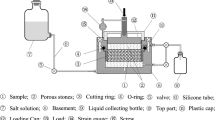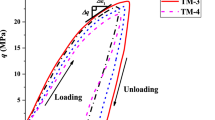Abstract
The goal in this research was to analyze the effects of decompression and suction on the formation of cracks in a clay rock from the Andra (French National Radioactive Waste Management Agency) site at Bure (Meuse–Haute-Marne, France). The article investigates the relationship between the changes in the hydromechanical properties and the changes in microstructure and porosity. Concerning the effect of decompression, at the macroscopic scale, the study highlighted an important effect on the elastic modulus and permeability, but little effect at the microscopic scale except an evolution of mineralogy related to the oxidation of pyrite often present in layers where cracks develop. Concerning the effect of suction, at the macroscopic level, the results showed that, on drying path, the change in the properties of the material was very small, whereas, on wetting path, a large decrease in tensile strength and gas permeability was observed. At the microscopic level, observations with SEM and ESEM, and measurements with MIP, highlighted the evolution of microstructural organization as a function of suction, and the propagation and enlargement of cracks on wetting path, rather than on drying path.


















Similar content being viewed by others
References
Al-Wardy W, Zimmerman RW (2004) Effective stress law for the permeability of clay-rich sandstones. J Geophys Res 109:B04203. doi:10.1029/2003JB002836
Andra (2009) Synthèse du programme de reconnaissance de la zone de transposition 2007–2008. Laboratoire de recherche scientifique Meuse/Haute-Marne. Rapport Andra no D.RP.ALS.08.1356
Auvray C (2004a) Essais géomécaniques Ouvrages EST209. Rapport Andra Report C.RP.0ENG.04.0380
Auvray C (2004b) Essais géomécaniques, ouvrage EST361, Laboratoire de Recherche Souterrain de Meuse/Haute-Marne. Andra Report C.RP.0ENG.04.0500
Baptist OC, Sweeney SA (1954) The effect of clays on the permeability of reservoir sands to waters of different saline contents. Clay Clay Miner 3:505–515
Baraka-Lokmane S (2002) Hydraulic versus pneumatic measurements of fractured sandstone permeability. J Pet Sci Eng 6:183–192
Barden L, Madedor AO, Sides GR (1972) The flow of air and water in partly saturated clay soil. In: Fundamentals of transport phenomena in porous media. IAHR ed., Elsevier, Amsterdam, pp 299–326
Bastiaens W, Bernier F, Li XL (2007) SELFRAC: experiments and conclusions on fracturing, self-healing and self-sealing processes in clays. J Phys Chem Earth 32:600–615
Bauer C (1997) Propriétés thermo-mécaniques des argilites silto-carbonatées de l’EST. Report G3S B RP 0G3S 95.003/A, 71 p
Bauer-Plaindoux C, Tessier D, Ghoreychi M (1998) Importance de l’organisation texturale dans le comportement mécanique des roches argileuses profondes. Colloque MAGI, 50, 21–22 Septembre 1998, pp 177–184
Bernabé Y (1987) A wide range permeameter for use in rock physics. Int J Rock Mech Min Sci Geomech Abstr 24:309–315
Blümling P, Bauer-Plaindoux C, Mayor JC, Alheid HJ, Fukaya M (2000) Geomechanical investigations at the underground rock laboratory Mont-Terri. In: Hoteit et al (eds) Rotterdam, Balkema, International workshop on THM modeling of argillaceous rocks, Ecole des Mines de Paris, France, pp 275–284
Brace WF (1984) Permeability of crystalline rocks: new in situ measurements. J Geophys Res 89:4327–4330
Brace WF, Walsh JB, Frangos WT (1968) Permeability of granite under high pressure. J Geophys Res 73:2225–2236
Cariou S, Duan Z, Davy CA, Skoczylas F, Dormieux L (2012) Poromechanics of partially saturated Cox argillite. Appl Clay Sci 56:36–47
Cariou S, Dormieux L, Skoczylas F (2013) An original constitutive law for Callovo-Oxfordian argillite, a two-scale double-porosity material. Appl Clay Sci 80–81:18–30
Charlier R (2008) Expertise sur les mesures sur échantillons d’argilite du module de déformation et de la résistance à la compression simple, Andra Report C.RP.0ULG.08.001
Chiarelli AS, Shao JF, Hoteit N (2003) Modeling of elastoplastic damage behavior of a claystone. Int J Plast 19:23–45
Cosenza P, Ghorbani A, Florsch N, Revil A (2007) Effects of drying on the low-frequency electrical properties of Tournemire argillites. Pure Appl Geophys 164:2043–2066
Darot M, Guéguen Y, Baratin M-L (1992) Permeability of thermally cracked granite. Geophys Res Lett 19:869–872
David C, Wong T-F, Zhu W, Zhang J (1994) Laboratory measurement of compaction-induced permeability change in porous rocks: implications for the generation and maintenance of pore pressure excess in the crust. Pure Appl Geophys 143:425–456
David C, Robion P, Menéndez B (2007) Anisotropy of elastic, magnetic and microstructural properties of the Callovo-Oxfordian argillite. Phys Chem Earth Parts A/B/C 32(1):145–153
Davy CA, Skoczylas F, Barnichon J-D, Lebon P (2007) Permeability of macro-cracked argillite under confinement: Gas and water testing. Phys Chem Earth 32:667–680
Debschütz W, Krückel U, Schopper JR (1991) Measurements of the hydraulic flow properties of crystalline rocks to characterize the internal pore-space structure. Sci Drill 2:58–66
Delage P, Pellerin M (1984) Influence de la lyophilisation sur la structure d’une argile sensible du Québec. Clay Miner 19:151–160
Dey TN (1986) Permeability and electrical conductivity changes due to hydrostatic stress cycling of Berea and Muddy sandstone. J Geophys Res 91:763–766
Diamond S (1970) Microstructure and pore structure of impact-compacted clays. Clays Clay Miner 19:239–249
Doyen PM (1987) Crack geometry in igneous rocks: a maximum entropy inversion of elastic and transport properties. J Geophys Res 92:8169–8186
Fleureau JM, Kheirbek-Saoud S, Soemitro R, Taibi S (1993) Behaviour of clayey soils on drying-wetting paths. Can Geotech J 30(2):287–296
Fouché O, Wright H, Cléac’h JM, Pellenard P (2004) Fabric control on strain and rupture of heterogeneous shale samples by using a non-conventional mechanical test. Appl Clay Sci 26:367–387
Gasc-Barbier M, Tessier D (2007) Structural modifications of a hard deep clayey rock due to hygro-mechanical solicitations. Int J Geomech 7(3):227–235
Gasc-Barbier M, Chanchole S, Berest P (2004) Creep behavior of Bure clayey rock. Appl Clay Sci 26(1):449–458
Gaucher EC, Robelin C, Matray JM, Negrel G, Gros Y, Heitz JF, Vinsot A, Rebours H, Cassagnabère A, Bouchet A (2004) ANDRA underground research laboratory: interpretation of the mineralogical and geochemical data acquired in the Callovian-Oxfordian formation by investigative drilling. Phys Chem Earth Parts A/B/C 29(1):55–77
Guéguen Y, Palciauskas V (1994) Introduction to the physics of rocks. Princeton University Press, Princeton
Hedan S, Fauchille A-L, Valle V, Cabrera J, Cosenza P (2014) One-year monitoring of desiccation cracks in Tournemire argillite using digital image correlation. Int J Rock Mech Min Sci 68:22–35
Hsieh PA, Tracy JV, Neuzil CE, Bredehoeft JD, Silliman SE (1981) A transient laboratory method for determining the hydraulic properties of ‘tight’ rocks- I. Theory. Int J Rock Mech Min Sci Geomech Abstr 18:245–252
Jones FO, Owens WW (1980) A laboratory study of low-permeability gas sands. J Pet Technol 7551:1631–1640
Klinkenberg LJ (1941) The permeability of porous media to liquids and gases. In: Drilling and productions practices. American Petroleum Institute, pp 200–213. doi:10.5510/OGP20120200114
Kwon O, Kronenberg AK, Gangi AF, Johnson B (2001) Permeability of Wilcox Shale and its effective pressure law. J Geophys Res 106:19339–19353
Le Ravalec M, Darot M, Reuschlé T, Guéguen Y (1996) Transport properties and microstructural characteristics of a thermally cracked mylonite. Pure Appl Geophys 146:207–227
Mohajerani M, Delage P, Monfared M, Tang AM, Sulem J, Gatmiri B (2011) Oedometric compression and swelling behavior of the Callovo-Oxfordian argillite. Int J Rock Mech Min Sci 48(4):606–615
Montes HG, Duplay J, Martinez L, Escoffier S, Rousset D (2004) Structural modifications of Callovo-Oxfordian argillite under hydration/dehydration conditions. Appl Clay Sci 25(3–4):187–194
Ougier-Simonin A, Sarout J, Gueguen Y (2009) A simplified model of effective elasticity for anisotropic shales. Geophysics 74:D57–D63
Pham QT, Valès F, Malinsky L, Nguyen MD, Gharbi H (2007) Effects of desaturation-resaturation on mudstone. Phys Chem Earth 32:646–655
Robinet JC, Sardini P, Siitari-Kauppi M, Prêt D, Yven B (2015) Upscaling the porosity of the Callovo-Oxfordian mudstone from the pore scale to the formation scale; insights from the 3H-PMMA autoradiography technique and SEM BSE imaging. Sed Geol 321:1–10
Sammartino S, Boucheta A, Prêta D, Parneixa J-C, Tevissen E (2003) Spatial distribution of porosity and minerals in clay rocks from the Callovo-Oxfordian formation (Meuse/Haute-Marne, Eastern France)—implications on ionic species diffusion and rock sorption capability. Appl Clay Sci 23:157–166
Sarout J, Gueguen Y (2008) Anisotropy of elastic wave velocities in deformed shales, part I: experimental results. Geophysics 73:D75–D89
Sarout J, Molez L, Guéguen Y, Hoteit N (2007) Shale dynamic properties and anisotropy under triaxial loading: experimental and theoretical investigations. Phys Chem Earth 32(8–14):896–906
Scheidegger AE (1974) The physics of flow through porous media, 3rd edn. University of Toronto Press, Toronto
Schmitt L, Forsans T, Santarelli J (1994) Shale testing and capillary phenomena. Int J Rock Mech Min Sci 31(5):411–427
Stauffer D (1985) Introduction to percolation theory. Taylor & Francis, London
Tang CS, Tang AM, Cui YJ, Delage P, Schroeder C, De Laure E (2011) Investigating the swelling pressure of compacted crushed-Callovo-Oxfordian claystone. Phys Chem Earth Parts A/B/C 36(17–18):1857–1866
Thorel L (1995) Argilites de Haute Marne: Caractérisation géomécanique. ANDRA Report B RP 0.G3S 95.003. 90 p
Valès F, Nguyen Minh D, Gharbi H, Rejeb A (2004) The influence of the degree of saturation on physical and mechanical properties in Tournemire shale. Appl Clay Sci 26:197–208
Wan M, Delage P, Tang AM, Talandier J (2013) Water retention properties of the Callovo-Oxfordian claystone. Int J Rock Mech Min Sci 64:96–104
Yang D, Billiotte J, Su K (2010) Characterization of the hydromechanical behavior of argillaceous rocks with effective gas permeability under deviatoric stress. Eng Geol 114(3):116–122
Yang D, Bornert M, Chanchole S, Gharbi H, Valli P, Gatmiri B (2012) Dependence of elastic properties of argillaceous rocks on moisture content investigated with optical full-field strain measurement techniques. Int J Rock Mech Min Sci 53:45–55
Yven B, Sammartino S, Geraud Y, Homand F, Villieras F (2007) Mineralogy, texture and porosity of Callovo-Oxfordian argillites of the Meuse/Haute-Marne region (eastern Paris Basin). Mém Soc géol France 178:73–90
Zhang C, Rothfuchs T (2004) Experimental study of the hydro-mechanical behaviour of the Callovo-Oxfordian argillite. Appl Clay Sci 26:325–336
Zhang C-L, Rothfuchs T (2007) Moisture effects on argillaceous rocks. In: Schanz T (ed) Proceedings of second international conference of mechanics of unsaturated soils, Springer proceedings in physics 112, pp 319–326
Zhang CL, Rothfuchs T, Su K, Hoteit N (2007) Experimental study of the thermohydro-mechanical behavior of indurated clays. Phys Chem Earth 32(8–14):957–965
Author information
Authors and Affiliations
Corresponding author
Rights and permissions
About this article
Cite this article
Wei, X., Duc, M., Hattab, M. et al. Effect of decompression and suction on macroscopic and microscopic behavior of a clay rock. Acta Geotech. 12, 47–65 (2017). https://doi.org/10.1007/s11440-016-0454-8
Received:
Accepted:
Published:
Issue Date:
DOI: https://doi.org/10.1007/s11440-016-0454-8




